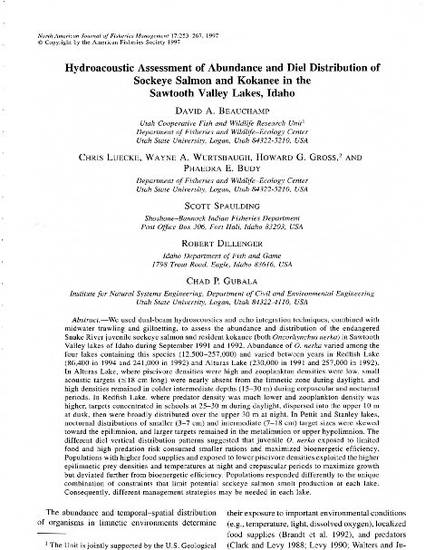
- hydroacoustic assessment,
- abundance,
- diel distribution,
- sockeye salmon,
- kokanee,
- Sawtooth Valley Lakes,
- Idaho
We used dual-beam hydroacoustics and echo integration techniques, combined with midwater trawling and gillnetting, to assess the abundance and distribution of the endangered Snake River juvenile sockeye salmon and resident kokanee (both Oncorhynchus nerka) in Sawtooth Valley lakes of Idaho during September 1991 and 1992. Abundance of O. nerka varied among the four lakes containing this species (12,500–257,000) and varied between years in Redfish Lake (86,400 in 1994 and 241,000 in 1992) and Alturas Lake (230,000 in 1991 and 257,000 in 1992). In Alturas Lake, where piscivore densities were high and zooplankton densities were low, small acoustic targets (≤18 cm long) were nearly absent from the limnetic zone during daylight, and high densities remained in colder intermediate depths (15–30 m) during crepuscular and nocturnal periods. In Redfish Lake, where predator density was much lower and zooplankton density was higher, targets concentrated in schools at 25–30 m during daylight, dispersed into the upper 10 m at dusk, then were broadly distributed over the upper 30 m at night. In Pettit and Stanley lakes, nocturnal distributions of smaller (3–7 cm) and intermediate (7–18 cm) target sizes were skewed toward the epilimnion, and larger targets remained in the metalimnion or upper hypolimnion. The different diel vertical distribution patterns suggested that juvenile O. nerka exposed to limited food and high predation risk consumed smaller rations and maximized bioenergetic efficiency. Populations with higher food supplies and exposed to lower piscivore densities exploited the higher epilimnetic prey densities and temperatures at night and crepuscular periods to maximize growth but deviated further from bioenergetic efficiency. Populations responded differently to the unique combination of constraints that limit potential sockeye salmon smolt production at each lake. Consequently, different management strategies may be needed in each lake.

Note: This article appears in the North American Journal of Fisheries Management and has been posted here with permission from the publisher.